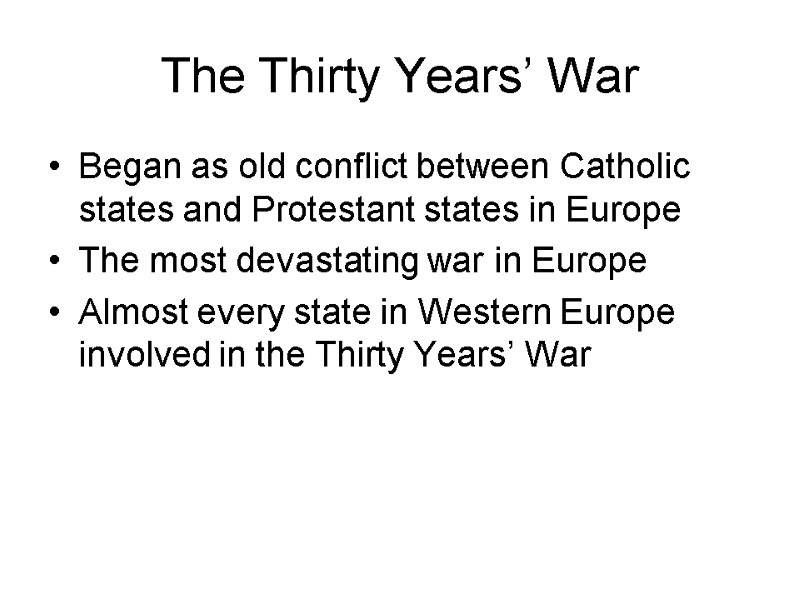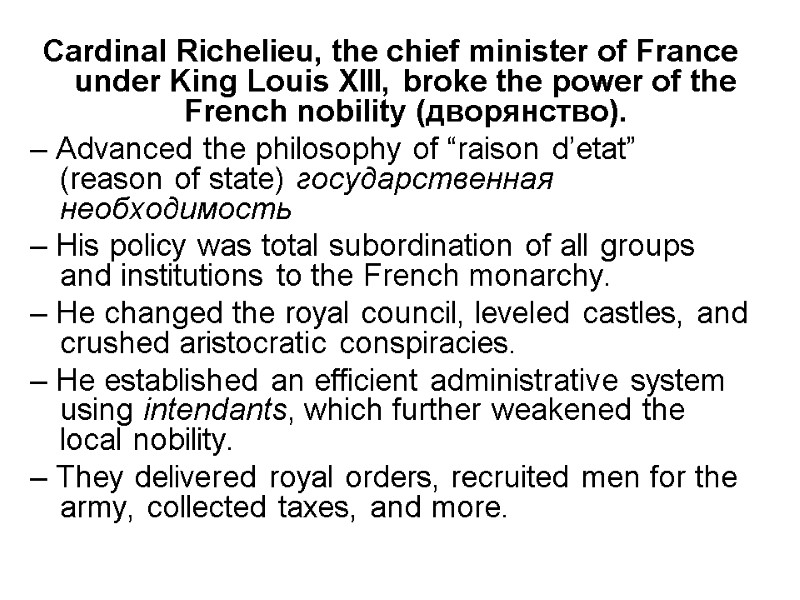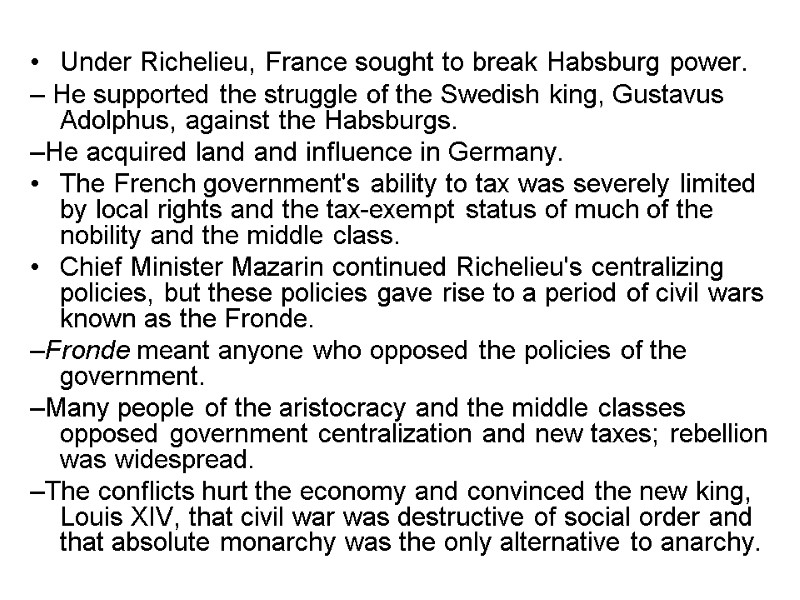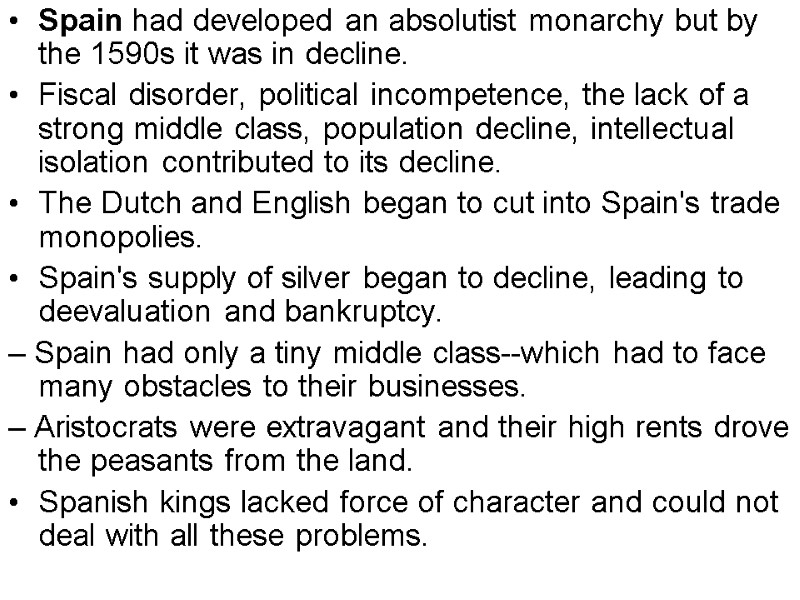The Thirty Years’ War Began as old conflict


The Thirty Years’ War Began as old conflict between Catholic states and Protestant states in Europe The most devastating war in Europe Almost every state in Western Europe involved in the Thirty Years’ War

The Thirty Years’ War Four Phases in the Thirty Years’ War: Bohemian (1618-1625) Danish (1625-1629) Swedish (1630-1635) Swedish-French (1635-1648) Ended with Treaty of Westphalia

French Absolutism The foundations of French absolutism: Henry IV and Duke de Sully Henry IV cared for his people, lowered taxes, achieved peace, and curtailed the power of the nobility. His minister, Sully, brought about financial stability and economic growth.

Cardinal Richelieu, the chief minister of France under King Louis XIII, broke the power of the French nobility (дворянство). – Advanced the philosophy of “raison d’etat” (reason of state) государственная необходимость – His policy was total subordination of all groups and institutions to the French monarchy. – He changed the royal council, leveled castles, and crushed aristocratic conspiracies. – He established an efficient administrative system using intendants, which further weakened the local nobility. – They delivered royal orders, recruited men for the army, collected taxes, and more.

Under Richelieu, France sought to break Habsburg power. – He supported the struggle of the Swedish king, Gustavus Adolphus, against the Habsburgs. –He acquired land and influence in Germany. The French government's ability to tax was severely limited by local rights and the tax-exempt status of much of the nobility and the middle class. Chief Minister Mazarin continued Richelieu's centralizing policies, but these policies gave rise to a period of civil wars known as the Fronde. –Fronde meant anyone who opposed the policies of the government. –Many people of the aristocracy and the middle classes opposed government centralization and new taxes; rebellion was widespread. –The conflicts hurt the economy and convinced the new king, Louis XIV, that civil war was destructive of social order and that absolute monarchy was the only alternative to anarchy.

– Louis XIV, the "Sun King," was a devout Catholic who believed that God had established kings as his rulers on earth. – He feared the nobility and was successful in collaboration with them to enhance both aristocratic prestige and royal power. – He made the court at Versailles a fixed institution and used it as a means of preserving royal power and as the center of French absolutism. The architecture and art of Versailles were a means of carrying out state policy--a way to overawe his subjects and foreign powers. The French language and culture became the international style. The court at Versailles was a device to undermine the power of the aristocracy by separating power from status. A centralized state, administered by a professional class taken from the bourgeoisie, was formed.

Financial and economic management under Louis XIV's minister, Jean Baptiste Colbert Louis's wars were expensive, but the tax farmers took much of the taxes while the nobility paid no taxes at all. Mercantilism is a collection of governmental policies for the regulation of economic activities by and for the state. Louis XIV's finance minister, Colbert, tried to achieve a favorable balance of trade and make France self-sufficient so the flow of gold to other countries would be halted. Colbert encouraged French industry, enacted high foreign tariffs, and created a strong merchant marine. He hoped to make Canada part of a French empire. Though France's industries grew and the commercial classes prospered, its agricultural economy suffered under the burdens of heavy taxation, population decline, and poor harvests.

Louis XIV kept France at war for 33 of the 54 years of his personal rule The French army under Louis XIV was modern because the state, rather than the nobles, employed the soldiers. Louis continued Richelieu's expansionist policy. In 1667, he invaded Flanders and gained twelve towns. By the treaty of Nijmegen (1678) he gained some Flemish towns and al of Franche-Comte. Strasbourg was taken in 1681 and Lorraine in 1684, but the limits of his expansion had been met. Louis fought the new Dutch king of England, Wil iam III, and the League of Augsburg in a war. – Louis's heavy taxes fell on the peasants, who revolted. This led to the War of the Spanish Succession (1701-1713), which was over the issue of the succession to the Spanish throne: Louis claimed Spain but was opposed by the Dutch, English, Austrians, and Prussians. – The war was also an attempt to preserve the balance of power in Europe and to check France's commercial power overseas. – A Grand Alliance of the English, Dutch, Austrians, and Prussians was formed in 1701 to fight the French. – The war was concluded by the Peace of Utrecht in 1713, which forbade the union of France and Spain.

Spain had developed an absolutist monarchy but by the 1590s it was in decline. Fiscal disorder, political incompetence, the lack of a strong middle class, population decline, intellectual isolation contributed to its decline. The Dutch and English began to cut into Spain's trade monopolies. Spain's supply of silver began to decline, leading to deevaluation and bankruptcy. – Spain had only a tiny middle class--which had to face many obstacles to their businesses. – Aristocrats were extravagant and their high rents drove the peasants from the land. Spanish kings lacked force of character and could not deal with all these problems.

Philip IV's minister Olivares mistakenly thought that revival of war with the Dutch would solve Spain's problems; war with France followed—all bringing disaster for Spain. –The Treaty of the Pyrenees of 1659, which ended the French Spanish wars, marked the end of Spain as a great power. Too much of Spain's past had been built on slavery and gold and silver. Cervantes's novel Don Quixote characterizes the impractical dreams of Spain.

The Dutch republic in the seventeenth century The Dutch republic (the United Provinces of the Netherlands) won its independence from Spain—as confirmed by the Peace of Westphalia in 1648. Power in the republic resided in the local Estates. –The republic was a confederation: a weak union of strong provinces. –The republic was based on values of thrift, frugality, and religious toleration, including that for Jews. –Religious toleration fostered economic growth. –A federal assembly called the States General handled national affairs. The States General appointed provincial representatives called Stadholders. These provincial representatives held a great deal of power, but the greatest power rested in the local Estates.
12070-the_thirty_years'_war.ppt
- Количество слайдов: 11

